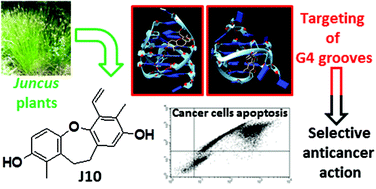Natural compounds from Juncus plants interacting with telomeric and oncogene G-quadruplex structures as potential anticancer agents
Abstract
Aiming at discovering novel, putative anticancer drugs featuring low-to-null side effects, natural compounds isolated from Juncaceae were studied here for their ability to target G-quadruplex structures originating from cancer-related telomeric and oncogene DNA sequences. Particularly, various dihydrophenanthrene, benzocoumarin and dihydrodibenzoxepin derivatives were firstly screened by the affinity chromatography-based G4-CPG assay, and the compound with the highest affinity and selectivity for G-quadruplexes (named J10) was selected for further studies. Fluorescence spectroscopy and circular dichroism experiments corroborated its capability to selectively recognize and stabilize G-quadruplexes over duplex DNA, also showing a preference for parallel G-quadruplexes. Molecular docking proved that the selective G-quadruplex interactions over duplex interactions could be due to the ability of J10 to bind to the grooves of the telomeric and oncogene G-quadruplex structures. Finally, biological assays demonstrated that J10 induces significant antiproliferative effects on human leukemia cells, with no relevant effects on healthy human fibroblasts. Interestingly, J10 exerts its antiproliferative action on tumor cells by activating the apoptotic pathway.

- This article is part of the themed collection: Chemical Biology in OBC


 Please wait while we load your content...
Please wait while we load your content...